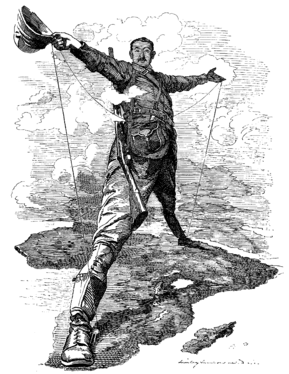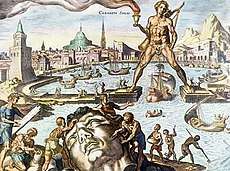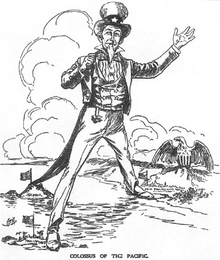The Rhodes Colossus
The Rhodes Colossus is an iconic editorial cartoon of the Scramble for Africa period, part of the New Imperialism, depicting British colonialist Cecil Rhodes as a giant standing over the continent.


History
The Rhodes Colossus was drawn by Edward Linley Sambourne, and first appeared in Punch magazine in 1892. It was widely reprinted in its time,[1] and has since become a standard illustration in history texts.[2]
The cartoon was published in the 10 December 1892 edition of Punch, appearing beside a recent excerpt from The Times about a Rhodes plan to extend an electrical telegraph line from Cape Town to Cairo.
It was led by a piece of satirical verse on the character and ambitions of Rhodes:[3]
THE World's Seven Wonders are surely outshone!
On Marvel World's billows 'twill toss us—'twill toss us,
To watch him, Director and Statesman in one,
This Seven-League-Booted Colossus—Colossus!
Combining in one supernatural blend
Plain Commerce and Imagination—gination;
O'er Africa striding from dark end to end,
To forward black emancipation—cipation.
Brobdingnagian Bagman, big Dreamer of Dreams.
A Titan of tact and shrewd trader—shrewd trader!
A diplomat full of finesse and sharp schemes,
With a touch of the pious Crusader—Crusader!
A "Dealer" with despots, a "Squarer" of Kings,
A jumper of mountain, lake, wilderness, wady,
And manager 'cute of such troublesome things
As Lobengula or the Mahdi—the Mahdi.
Well may Abercorn wonder and Fife tootle praise,
His two thousand hearers raise cheering—raise cheering.
Of wild would-be Scuttlers he proves the mad craze,
And of Governments prone to small-beering—small-beering.
Sullen Boers may prove bores to a man of less tact,
A duffer funk wiles Portuguesy—tuguesy;
But Dutchmen, black potentates, all sorts, in fact,
To Rhodes the astute come quite easy—quite easy.
The British South-African Company's shares
May be at a discount—(Trade-martyrs!—trade-martyrs!)—
But he, our Colossus, strides on, he declares,
Whether with or without chums or charters—or charters.
Hooray! We brave Britons are right now to the front—
Provided we've someone to boss us—to boss us;
And Scuttlers will have their work cut out to shunt
This stalwart, far-striding Colossus—Colossus!— Verse accompanying the original cartoon[3]
Iconography and influence

Rhodes is shown in a visual pun as the ancient Greek statue the Colossus of Rhodes, following the traditional (and architecturally unlikely) depiction of the Colossus with wide-set legs across Rhodes harbour (above).
Rhodes measures with the telegraphic line the distance from Cape Town (at his right foot) in South Africa to Cairo (at his left foot) in Egypt, illustrating his broader "Cape to Cairo" concept for British domination of Africa.
The cartoon is recognised today as a standard illustration in history texts of the Scramble for Africa, and of colonialism as a whole. The original context of a proposed telegraph line is rarely mentioned in such reproductions, which take the "Cape to Cairo" concept more generally.
In 2009, the South African cartoonist Jonathan Shapiro parodied the famous cartoon by placing Chinese premier Wen Jiabao in place of Rhodes holding up Nkosazana Dlamini-Zuma, the then Minister of Foreign Affairs, like a marionette, while the Dalai Lama looks on from Asia.[4] The cartoon satirised Sino-African relations in general, and recent China-South Africa relations in particular, after the Dalai Lama was denied a visa to attend an international peace conference in Johannesburg, a move that was perceived to be the result of Chinese pressure.[5][6]
The Rhodes cartoon also influenced political cartoonist Martin Rowson, who published on 1 February 2013 a drawing[7] in The Guardian on British prime minister David Cameron's policy regarding Algeria and the French intervention in Mali.
References
- Empires, Exceptions, and Anglo-Saxons: Race and Rule between the British and United States Empires, 1880–1910
- Richard Scully, ‘Constructing the Colossus: the Origins of Linley Sambourne’s Greatest Punch Cartoon’, International Journal of Comic Art, Volume 14, No.2, Fall 2012, pp.120–142.
- Punch, Volume 103, 10 December 1892
- "The Rhodes Colossus - 118 Years Later". Zapiro. 5 April 2009. Retrieved 14 June 2016.
- "Dalai Lama denied visa for South Africa peace conference". CNN. 23 March 2009. Retrieved 21 April 2013.
- "Tibetans blame China for Dalai Lama visa denial". Mail & Guardian. 23 March 2009. Retrieved 21 April 2013.
- "Cameron's African adventure". The Guardian. 1 February 2013. Retrieved 1 February 2013.
External links
- Punch, 10 December 1892, from Project Gutenberg
- Richard Scully, ‘Constructing the Colossus: the Origins of Linley Sambourne’s Greatest Punch Cartoon’, International Journal of Comic Art, Volume 14, No.2, Fall 2012, pp. 120–142: